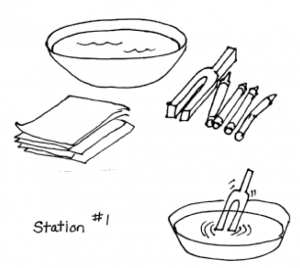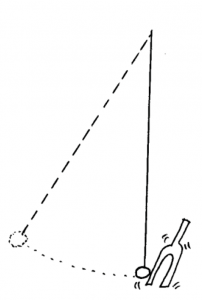From the Dangerous Decibels Educator Resource Guide.
Interactive lessons demonstrating the connection between sound and vibrations.
Science Topics
Hearing
Sound
Vibrations
Energy
Process Skills
Listening
Observing
Scientific Inquiry
Health Skills
Grade Level
K-12
Preparation
30 minutes
Set-Up
15 minutes
Activity
30 minutes
Clean-Up
5 minutes
Downloads
Materials in Kit
Tuning Fork
Ping-Pong Ball with string attached
Materials not in Kit
1-2 quart pan or unbreakable bowl
2-3 cups of water
paper
crayons
Set-Up
Set the supplies at each station as follows:
Station 1– Ripples on Water/Tuning Fork
Add water to the pan or bowl to approximately two inches deep.
Place crayons, paper, a tuning fork, and the pan of water at the table.
Station 2 – Sound Moves/Tuning Fork
Cut a piece of string approximately one foot long.
Tape one end of string to a ping-pong ball.
Place string with ping-pong ball and a tuning fork at the table.
If you do not have tuning forks, check out this video: https://www.youtube.com/watch?v=vNuDxc9tZMk
Introduce the Activity
Begin with an introductory, interactive demonstration in which students feel the vibrations created by their own voices. Talk to
or ask the students the questions in bold. Possible student
responses are shown in italics.
We are going to feel the movement made by our voices when we talk, sing, hum, or shout.
(Note: Tiny repeating movements are called vibrations)
Can you feel the sound of your voice by putting your hand on your body while you talk?
Where do you think is the best place to feel your body move when you talk, sing, or hum?
(Note: Encourage a variety of answers. Each answer represents what they know about sound. Students may
think the vibrations will be strongest coming from their mouths, but they are actually stronger at the throat.)
Test your hypotheses with a partner. Have students test various hypotheses suggested by the class and
possibly the teacher. Test by having students place their hand on a part of their body while they talk.
Include testing of the face and throat. Have each student hold her hand against her own face as she talks and feel the movement (vibrations).
Next, have students put a finger on the front of their throat, close to their “voice box,” (middle of the throat) being careful not to press too hard.
Do you feel tiny movements from speaking?
Where do you feel them best?
Ask students to share their observations.
Demonstrate the two activity stations before students divide into groups and do the activities.
Doing the Activity
Station 1 – Ripples on Water/Tuning Fork:

- Strike a tuning fork against a book and dip the fork in the pan or bowl of water.
- Tell students that when they do this activity, they will also have paper and crayons to draw what they see.
- To think about: What did you feel when you touched the tuning fork after you hit it?
Caution: the resonating (fork) end of the tuning fork should only be placed in the water. Do not put the resonating end of the fork against the windows, eye glasses, or teeth. The tuning fork can shatter glass.
Station 2 – Sound Moves:

- Have one student in a standing position hold the string with the ping-pong ball at arm’s length. Be sure the student is holding it as still as possible.
- Have another student gently move the tuning fork towards the ping-pong ball until it just barely touches it.
- Have the second student strike the tuning fork against a book or shoe and again gently move the tuning fork towards the ping-pong ball until it just barely touches it.
- One more time, have the same student gently touch the ping-pong ball with the tuning fork.
Ask the students the questions in bold and facilitate an open ended discussion. Possible answers are shown in italics.
What did you feel when you touched the tuning fork after you hit it? What did you observe happening to the water?
What happened when you touched the ping-pong ball with the tuning fork the first time?
What happened to the ping-pong ball when you touched it the first time after hitting the tuning fork on a book?
What happened when you touched it a second time?
Did anything surprise you when the tuning fork touched the ping-pong ball? Why do you think the ping-pong ball moved?
What else did you notice (observe) with your eyes or ears?
Can we see sound move?
The sound made by the tuning fork made a pattern of waves that showed in the water. If we could see the air around us, we would be able to see the same kind of waves as sound moves through the air from a radio to your ears.
Can sound move things?
Energy (vibration) is transferred from the tuning fork to the ping-pong ball. The amount of energy transferred will determine how far the ping-pong ball moves.
This sound movement is felt by special parts of your ear (tiny hair cells of the inner ear). Deep inside your ear, sound waves actually move small vibration sensors called hair bundles. These parts of your ear are much smaller than grains of sand. If sound is strong (loud) enough, the sound waves cause some of them to bend or break. When you are around loud sounds often, or for a long time, you may begin to have trouble hearing.
Do you know anyone who seems to have trouble hearing some sounds?
Give examples of some loud sounds you are exposed to in your environment.
Note: Loud sounds are not the only cause of hearing loss, but it is the most common cause in America (and in other industrialized nations). Loud sounds (above 85 dB for 8 hours or more) can hurt your ears by damaging the sensitive hair cells of the inner ear. It makes no difference whether you like the loud sounds or not – if they are 85 dB and over, they can begin to damage hair cells in your inner ear.
Doctors cannot fix ears that have been damaged by loud sound so it is very important to protect your ears.
Here is what you can do:
- Turn it down (turn the volume down)
- Walk away (get far away from the loud sound)
- Wear ear muffs or ear plugs
QUESTIONS TO TELL IF YOU ARE AROUND SOUND THAT MAY HARM YOUR HEARING:
- □ Do you often have to shout for people to hear you?
- □ After being around loud sound, did you ever have a ringing or other noises in your ears or head (tinnitus)?
- □ Does music sound a little strange after you listen for a while?
- □ After being near loud sound, does it sound like people are talking to you through a pillow or underwater?
- □ After being near loud sound, do your ears sometimes feel “full” or “stopped up”?
- □ When you are listening to stereo headphones does the person next to you need to raise their voice for you to understand what they are saying?
- If you answered YES to any of these questions, you may have been exposed to damaging sound levels.
Explanation
Read about the Physics of Sound on page 4.
Sound is produced when an object vibrates. Near the vibrating surface, air follows that surface and the air molecules begin to vibrate, or oscillate. These oscillations spread from one molecule to the next, and a sound wave moves outward from the vibrating surface. The intensity of the waves (amplitude) and how rapidly they repeat (frequency) produce the differences in sound. More intense oscillation produces a louder sound. Faster oscillations produce higher pitched sounds. When sound waves travel through the air, the oscillation of the air molecules next to the surface of an object (such as the surface of the drum) will cause that object to vibrate. You can even feel the sound energy with a light fingertip touch on many of the objects used in this activity.
